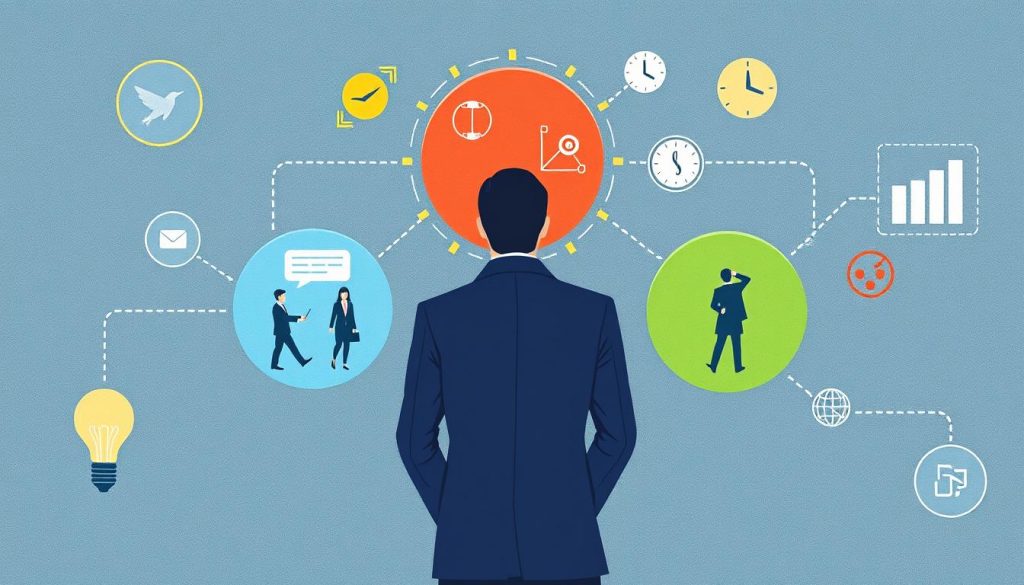The modern workplace has undergone a significant transformation. With the pandemic spurring a shift towards remote work, the boundaries between professional and personal spaces have become increasingly blurred.
As a result, achieving a balance between work and personal life has become a pressing concern for many professionals. The consequences of neglecting this balance can be severe, with 95% of human resources executives citing employee burnout as a leading cause of workforce turnover.
To address this challenge, it’s essential to adopt effective strategies that foster a harmonious integration of work and personal life. By doing so, professionals can improve their overall well-being, productivity, and life satisfaction.
Table of Contents
Key Takeaways
- Achieving a balance between work and personal life is crucial for professionals.
- The pandemic has blurred the boundaries between professional and personal spaces.
- Effective strategies can foster a harmonious integration of work and personal life.
- Improved well-being, productivity, and life satisfaction are potential benefits.
- Organizations must prioritize employee well-being to mitigate burnout.
Understanding Work-Life Integration
The concept of work-life integration has emerged as a vital strategy for managing the demands of modern life. It’s about integrating one’s work and life to complement and support each other, allowing space for both work and personal life so that you can feel fulfilled in both aspects.
The Evolution of Work-Life Concepts
Over recent decades, work-life concepts have evolved significantly, reflecting changing societal attitudes and technological developments. The traditional 9-to-5 workday model has given way to more flexible approaches that acknowledge the unique needs and circumstances of individuals. This shift is driven by the recognition that work and life are not mutually exclusive, but can complement each other.
For more insights on finding your ideal work-life balance, visit this resource.
Core Principles of Work-Life Integration
The core principles of work-life integration include flexibility, personalization, and the recognition that work and personal life can complement rather than compete with each other. This approach recognizes that individuals have different priorities, energy patterns, and life circumstances that influence their optimal work arrangements. By adopting these principles, individuals can efficiently coordinate their workday schedules and personal responsibilities, ensuring personal and professional productivity and higher satisfaction.
Ultimately, work-life integration is not about achieving a ‘perfect’ balance between work and life, but about finding a balance that works for you, which will vary over time as your circumstances change.
Work-Life Integration vs. Work-Life Balance

Understanding the differences between work-life integration and work-life balance is crucial for achieving a balanced life. While both concepts aim to harmonize professional and personal responsibilities, they differ significantly in their approaches and implications.
Traditional Work-Life Balance Approach
The traditional work-life balance approach emphasizes creating a clear distinction between work and personal life. It advocates for allocating equal time and energy to both domains, often resulting in a rigid separation between professional and personal responsibilities. This method can sometimes create artificial divisions, making it challenging for individuals to manage unexpected work or personal demands.
A typical example of work-life balance in practice is the standard 9-to-5 work schedule, where employees are expected to focus solely on work during work hours and then completely disconnect from work-related tasks during their personal time. The following table illustrates the key characteristics of this approach:
| Characteristics | Description |
|---|---|
| Time Allocation | Equal time for work and personal life |
| Boundary Setting | Rigid separation between work and personal life |
| Flexibility | Limited flexibility to accommodate unexpected demands |
The Modern Work-Life Integration Paradigm
In contrast, work-life integration adopts a more fluid approach, acknowledging that work and personal life can overlap. It allows individuals to manage their responsibilities in a more flexible manner, choosing when and how to complete tasks based on their needs and circumstances. This paradigm recognizes that modern life is not always linear and that personal and professional responsibilities can intersect.
For instance, with work-life integration, an individual might attend to personal matters during the workday if necessary, or work on professional tasks during personal time if that’s more convenient or productive. This flexibility can lead to greater efficiency and reduced stress, as individuals are not constrained by rigid boundaries.
By understanding these two approaches, individuals can better choose the strategy that suits their lifestyle, work requirements, and personal preferences, ultimately leading to a more balanced and fulfilling life.
Benefits of Embracing Work-Life Integration

By adopting work-life integration, individuals and organizations can experience significant improvements in overall well-being and productivity. This approach allows for a more natural flow between professional responsibilities and personal activities, reducing the pressure of maintaining strict boundaries.
Reduced Stress and Improved Well-being
One of the primary benefits of work-life integration is the reduction in stress levels. By eliminating the artificial pressure to separate work and personal life, individuals can enjoy a more natural flow between activities. This leads to improved overall well-being and a healthier lifestyle for employees.
Enhanced Productivity and Performance
Work-life integration allows individuals to work during their most productive periods, which may not necessarily align with traditional working hours. This flexibility can enhance performance and output quality, ultimately benefiting both the individual and the organization.
Greater Flexibility and Autonomy
With integration, individuals have greater autonomy in managing their schedules. This flexibility leads to improved job satisfaction and employee loyalty, as well as a more positive overall workplace culture.
Improved Job Satisfaction and Retention
By creating a work environment that respects and accommodates individual life circumstances, organizations can significantly improve employee retention. This approach demonstrates a commitment to employee well-being, leading to higher job satisfaction and reduced turnover rates. For more insights on personal fulfillment, visit this resource on personal growth.
- Reduced stress through a natural flow between work and personal life
- Enhanced productivity by working during peak periods
- Greater flexibility and autonomy in schedule management
- Improved job satisfaction and employee retention
- Positive impact on physical and mental health
Potential Challenges of Work-Life Integration
While work-life integration offers numerous benefits, it also presents several challenges that need to be addressed. As individuals blend their work and personal lives, they may encounter difficulties in maintaining a healthy balance.
Blurred Boundaries
The blurring of lines between work and personal life can lead to difficulty in fully disengaging from professional responsibilities. This can impact personal relationships and personal time, making it challenging to relax and recharge. When work can be done from anywhere at any time, it can be hard to establish a clear distinction between work hours and personal time.
Risk of Overworking
The risk of burnout increases when the distinction between work and personal time blurs, leading to longer work hours and the pressure to be always available. Employees who have blended their work and personal lives may have difficulty disconnecting, which can undermine the benefits of work-life integration.
Individual Suitability
Work-life integration may not be equally suitable for all personality types, job roles, or industries. It requires personalized approaches rather than one-size-fits-all solutions. Individuals need to be aware of these challenges to proactively address them when developing their own integration strategies.
- Establishing clear boundaries between work and personal life
- Managing the risk of overworking and burnout
- Adapting work-life integration to individual needs and circumstances
By understanding these challenges, individuals can better navigate the complexities of work-life integration and create a more balanced and sustainable approach to their work and personal lives.
Practical Work-Life Integration Strategies for Individuals

Embracing work-life integration is about more than just balancing work and personal life; it’s about creating a seamless blend that enhances overall well-being. To achieve this, individuals must employ intentional strategies that manage their work and personal responsibilities effectively.
Setting Clear Boundaries and Expectations
Setting clear boundaries is crucial for maintaining a healthy work-life integration. This involves communicating your work hours and availability to colleagues, clients, and family members to prevent overwork and ensure dedicated personal time.
Clear expectations help in managing the demands from both work and personal life, reducing the risk of burnout.
Creating a Personalized Integration Schedule
Creating a schedule that aligns with your energy patterns and priorities is essential. This means identifying your most productive times of the day for work and scheduling personal activities during less productive times.
By doing so, you can maximize your productivity and ensure that both work and personal responsibilities are attended to effectively.
Leveraging Technology Effectively
Technology can be a powerful tool in achieving work-life integration. It allows for flexibility in work arrangements and can enhance productivity.
However, it’s crucial to leverage technology mindfully, avoiding the pitfall of being constantly connected and ensuring that technology serves to enhance rather than control your life.
Practicing Self-care and Mindfulness
Practicing self-care and mindfulness is vital in maintaining well-being amidst the demands of work and personal life.
Engaging in mindfulness practices such as meditation or yoga can help manage stress and improve overall well-being.
How Organizations Can Foster Work-Life Integration
Employers can significantly impact their employees’ ability to achieve work-life integration by implementing the right policies and culture. By doing so, organizations can create environments that support effective work-life integration, resulting in improved retention, satisfaction, and productivity.
Implementing Flexible Work Policies
Organizations can start by introducing flexible work policies that allow employees to manage their work and personal responsibilities more effectively. This can include flexible hours, remote work options, and results-oriented work environments that focus on outcomes rather than time spent.
Providing Customizable Employee Benefits
Another key strategy is to offer customizable employee benefits that cater to the diverse needs of the workforce. By providing a range of benefits, employers can support employees across different life stages, family situations, and personal priorities, thereby promoting work-life integration.
Creating a Supportive Company Culture
A supportive company culture is crucial for normalizing and supporting work-life integration. This involves moving beyond policy to create a genuine acceptance of flexible working arrangements among employees and management alike.
Leading by Example: Management’s Role
Leadership behavior and management practices play a significant role in the success of work-life integration initiatives. It is essential for leaders to model the behaviors they expect from their employees, demonstrating a commitment to work-life integration from the top down.
By adopting these strategies, organizations can foster a culture that supports work-life integration, leading to a more balanced, productive, and satisfied workforce.
Conclusion: Creating Your Sustainable Work-Life Integration Plan
Embracing work-life integration is a powerful strategy for enhancing overall well-being. By blending our daily activities to align with our individual preferences and life circumstances, we can achieve a better balance between our professional and personal lives. However, it’s crucial to acknowledge the potential downsides, including the risk of burnout and the challenges of maintaining clear boundaries.
To mitigate these risks, both employees and employers must be deliberate in implementing practices that promote well-being. Start with small, manageable changes, and regularly reassess your integration strategy to ensure it continues to serve both your professional goals and personal well-being. For more insights on achieving a harmonious balance, explore resources like this article, which discusses the role of portage salarial in work-life balance.
By adopting a personalized and flexible approach to work-life integration, you can create a more fulfilling and sustainable way of living and working.
FAQ
What is the main goal of achieving a balance between professional and personal life?
The primary objective is to create a harmonious balance that allows individuals to manage their professional responsibilities while maintaining their personal well-being. This balance is crucial for reducing stress and improving overall quality of life.
How can I effectively manage my time to achieve a better balance between work and personal life?
To manage your time effectively, it’s essential to set clear boundaries and prioritize tasks. Creating a personalized schedule that accommodates both work and personal activities can help you stay organized and focused.
What are the benefits of having a flexible work schedule?
Having a flexible work schedule allows you to have greater autonomy and flexibility in managing your work and personal responsibilities. This can lead to improved job satisfaction and reduced turnover rates.
How can organizations support their employees in achieving a better balance between work and personal life?
Organizations can support their employees by implementing flexible work policies, providing customizable employee benefits, and creating a supportive company culture. This can help employees manage their work and personal responsibilities more effectively.
What are some common challenges associated with integrating work and personal life?
Some common challenges include blurred boundaries between work and personal life, the risk of overworking, and burnout. It’s essential to be aware of these challenges and take steps to mitigate them.
How can I prioritize self-care and maintain my well-being while managing my work and personal responsibilities?
Prioritizing self-care and mindfulness is crucial for maintaining your overall well-being. This can involve engaging in activities that promote relaxation and stress reduction, such as meditation or exercise.
What role do leaders and managers play in promoting a healthy balance between work and personal life?
Leaders and managers play a crucial role in promoting a healthy balance by leading by example and creating a culture that supports work-life integration. They can foster an environment that encourages employees to manage their work and personal responsibilities effectively.





